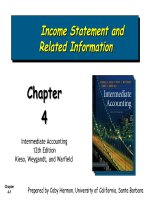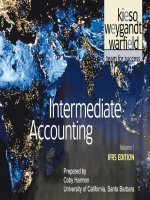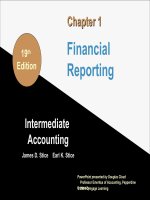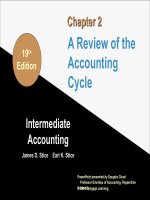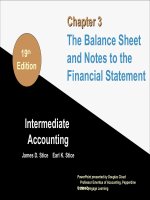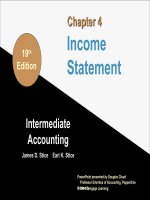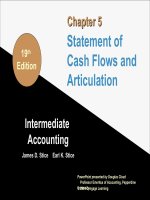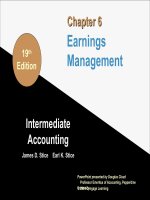Intermediate accounting 19th by stice stice chapter 04
Bạn đang xem bản rút gọn của tài liệu. Xem và tải ngay bản đầy đủ của tài liệu tại đây (191.87 KB, 52 trang )
Chapter 4
19
Edition
th
Income
Statement
Intermediate
Accounting
James D. Stice
Earl K. Stice
PowerPoint presented by Douglas Cloud
Professor Emeritus of Accounting, Pepperdine
University
© 2014 Cengage Learning
4-1
What It Is and What It Isn’t
•
Income is not equal to the amount of cash
generated from the successful operation of the
business.
•
Income is a return over and above the
investment.
•
It is the amount that an entity could return to
its investors and still leave the entity as well-off
at the end of the period as it was at the
beginning.
4-2
Financial Capital Maintenance
Concept of Income Determination
The financial capital maintenance concept
assumes that a company has income “only if
the dollar amount of an enterprise’s net
assets at the end of the period exceeds the
dollar amount of net assets at the beginning
of the period after excluding the effects of
transactions with owners.
(continued)
4-3
Financial Capital Maintenance
Concept of Income Determination
Kreidler, Inc. had the following assets and
liabilities at the beginning and at the end of a
period.
Total assets
Total liabilities
Net assets
(owners’ equity)
Beginning
of Period
End of
Period
$510,000
$560,000
430,000
390,000
Income is $90,000
$ 80,000
$170,000
(continued)
4-4
Financial Capital Maintenance
Concept of Income Determination
If the owners invested $40,000 in the
business and received dividends of $15,000,
what would be the income?
Net assets, end of period
Net assets, beginning of period
Change (increase) in net assets
Deduct investment by owners
Add dividends to owners
Income
$170,000
80,000
$ 90,000
(40,000)
15,000
$ 65,000
4-5
Physical Capital Maintenance
Concept of Income Determination
• Income per physical capital maintenance
•
•
occurs only if physical production capacity
at the end of the period exceeds the
physical production capacity at the
beginning of the period.
This concept requires that productive
assets be valued at fair market value.
Productive capital is maintained only if the
current costs of these capital assets are
maintained.
4-6
Physical Capital Maintenance
Concept of Income Determination
Practical
Practical Difficulties
Difficulties
a) Difficulty in estimating depreciation lives
b) Difficulty in implementing internal control
procedures
c) Difficulty in providing cash flow
information
d) Difficulty in obtaining fair market values of
The FASBand
adopted
the financial capital maintenance
assets
liabilities
concept as part of the conceptual framework.
4-7
Why is a Measure of
Income Important?
The recognition, measurement, and
reporting (display) of business income and
its components are considered by many to
be the most important tasks of accountants.
For example:
•
•
•
Has the activity been profitable?
What is the trend of profitability?
Is it increasing profitable, or is there a
downward trend?
(continued)
4-8
Why is a Measure of
Income Important?
In the United States, the FASB has
specified that financial accounting
information is designed with investors and
creditors in mind, while at the same time
recognizing that many other groups will find
the resulting information useful as well.
Accrual-based financial
accounting information is not
suited for every possible use.
(continued)
4-9
Why is a Measure of
Income Important?
•
In code law countries, such as Germany
and Japan, accounting standards have
historically been set by legal processes.
•
In a common law country, such as the
United States and the United Kingdom,
accounting standards are set in response
to market forces.
4-10
Transaction Approach
• To provide detail concerning the components of income,
accountants have adopted a transaction approach to
measuring income that stresses the direct computation of
revenues and expenses.
• The transaction approach, sometimes referred to as the
matching method, focuses on business events that effect
certain elements of the financial statements.
(continued)
4-11
Revenue and Gain Recognition
•
•
Under GAAP of accrual accounting,
revenue recognition does not necessarily
occur when cash is received.
Revenues and gains are recognized when:
1. they are realized or realizable, and
2. they have been earned through substantial
completion of the activities involved in the
earnings process.
(continued)
4-12
Revenue and Gain Recognition
•
•
Revenues are recognized when the
company generating the revenue has
provided the bulk of the goods or services it
promised for the customer and when the
customer has provided payment or at least
a valid promise of payment to the company.
In order for revenue to be recognized,
inventory or other assets must be
exchanged for cash or claims to cash, such
as accounts receivable.
4-13
Expense and Loss Recognition
Direct
Direct Matching
Matching
•
Relating expenses to specific revenues is
often referred to as the matching process.
•
For example, shipping costs and sales
commissions usually relate directly to
revenues.
•
Certain expenses have to be estimated to be
matched against recognized revenue for the
period.
(continued
)
4-14
Expense and Loss Recognition
Systematic
Systematic and
and
Rational
Rational Allocation
Allocation
The cost of assets that benefit more
than one period, such as buildings,
equipment, patents, and prepaid
insurance, are spread across the
periods of expected benefit in some
systematic and rational way.
4-15
Expense and Loss Recognition
Immediate
Immediate Recognition
Recognition
•
•
Many expenses are not related to specific
revenues but are incurred to obtain goods
and services that indirectly help to
generate revenues.
Examples include office salaries, utilities,
and general advertising. These are
recognized as expenses in the period in
which they are incurred.
4-16
Gains and Losses from Changes
in Market Values
•
An exception to the transaction approach in
the recognition of gains and losses arises
when gains or loss are recognized in the
wake of changes in market value.
•
When a long-term asset, such as a building,
has decreased substantially in value (an
impairment), a loss is recognized even
though the building has not been sold and no
transaction has occurred.
4-17
Form of the Income Statement
• Traditionally, the income from the
continuing operations category has
been presented in multiple-step form.
• Using this format, the income statement
is divided into separate sections, and
various subtotals reflect different levels
of profitability.
(continued
)
4-18
Form of the Income Statement
•
•
Comparative financial statements
present several years’ financial
statements side by side. This enables
users to analyze performance over
multiple periods and identify significant
trends.
Consolidated financial statements
combine the financial results of the
“parent company” with other companies
that it owns, called subsidiaries.
4-19
Income from Continuing
Operations
1. Revenue
2. Cost of goods sold
3. Operating expenses
4. Other revenues and gains
5. Other expenses and losses
6. Income taxes on continuing operations
(continued)
4-20
Income from Continuing
Operations
Determining
Determining Subtotals
Subtotals
Gross profit =
(Revenue – Cost of goods sold)
Operating income =
(Gross profit – Operating expenses)
(continued)
4-21
Income from Continuing
Operations
Determining
Determining Subtotals
Subtotals
Income from continuing operations before taxes
(Operating income + Other revenues and gains
– Other expenses and losses)
Income from continuing operations (Income from
continuing operations before income taxes –
Income taxes on continuing operations)
(continued)
4-22
Income from Continuing
Operations
Revenue
Revenue
•
Revenue reports the total sales to
customers for the period less any sales
returns and allowances or discounts.
•
Sales returns and allowances and sales
discounts should be subtracted from gross
sales revenue in arriving at net sales
revenue.
(continued)
4-23
Income from Continuing
Operations
Cost
Cost of
of Goods
Goods Sold
Sold
+
+
+
=
–
=
Beginning inventory
Net purchases
Freight-in
Other inventory acquisition costs
Cost of goods available for sale
Ending inventory
Cost of goods sold
(continued)
4-24
Income from Continuing
Operations
Cost
Cost of
of Goods
Goods Sold
Sold
• Cost of goods sold is a significant item on
merchandising and manufacturing
companies’ income statements.
• A manufacturing company has three
inventories rather than one: raw materials,
goods in process, and finished goods.
(continued)
4-25
